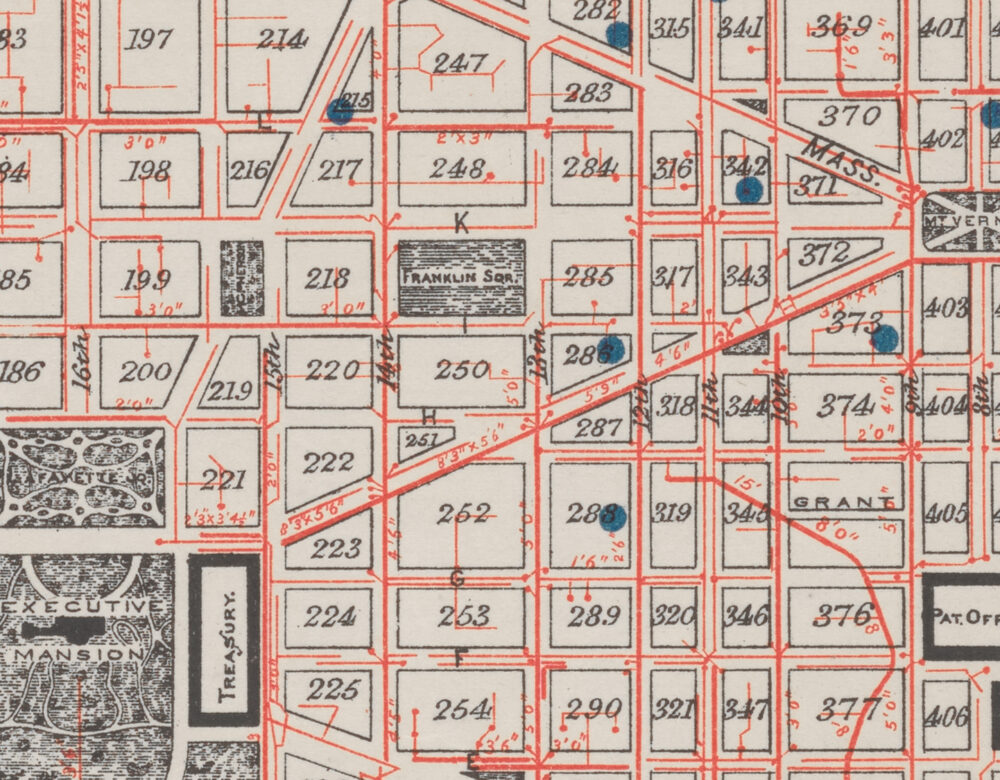In October 2020, during some of the worst days of the COVID-19 pandemic, colleges across the country were scrambling to keep their students healthy and their doors open. At Colorado College, a liberal arts school in Colorado Springs, math professor Andrea Bruder did her part by slipping on a biohazard suit and crawling through a tunnel below a freshman dorm.
Squatting in the dark, cramped space, Bruder held a plastic ladle and a to-go coffee cup near an open sewer pipe, waiting for someone to flush.
“You just pray that someone goes to the bathroom?” asked an NPR reporter who accompanied her into the tunnel.
“I just wait and listen for somebody to flush, yeah,” Bruder responded with a slight laugh. After 20 minutes, they heard a toilet’s soft roar echo down the pipe.
“It was a very good flush, and now it takes a little while to get there,” she said. “And here’s some TP,” she added, noting fragments of toilet paper as the sample trickled out.
The collected liquid was taken to a lab, where testing showed it did not contain traces of the coronavirus. But similar operations at other schools found evidence of infection. At the University of Arizona, a positive wastewater result in August 2020 led the school to test all 311 residents of a dormitory. Officials found two asymptomatic, infected students, who were quickly quarantined.
Testing wastewater is less expensive and invasive than swabbing thousands of students’ noses and analyzing all those samples individually. It can also be done almost continuously. As of late 2020 at least five dozen colleges had set up sewage-testing programs.
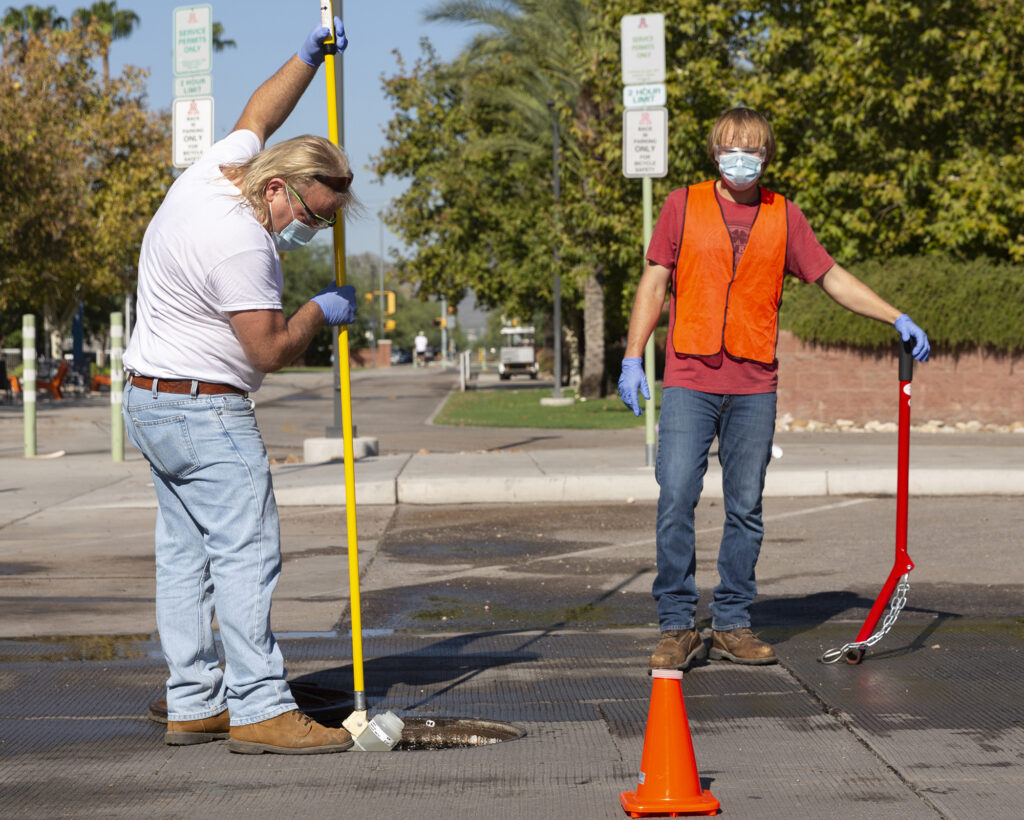
Collecting a wastewater sample from a dorm sewage line at the University of Arizona, August 2020.
Hundreds of local governments and sewer authorities also embraced testing, and the Centers for Disease Control created a National Wastewater Surveillance System to collect and publish data on COVID-19 levels across the country. The agency is now planning to expand the program to monitor influenza, respiratory syncytial virus, foodborne illnesses, monkeypox, and the infectious fungus Candida auris.
“We’ve launched a new revolution in the way that we monitor infectious diseases,” Emory University microbiologist Marlene Wolfe told the Association of American Medical Colleges. Wolfe helped design an early COVID-19 wastewater testing program in the San Francisco Bay Area.
Sewage surveillance has seen unprecedented growth in a very short period. The field is undergoing a rapid transformation from a “fringe science,” in the words of one researcher, to a mainstay of public health and a multibillion-dollar industry.
Yet it hardly came out of nowhere. Wastewater-based epidemiology, or WBE, has a long history that has repeatedly demonstrated the technology’s usefulness, as well as its potential perils. From early on, scientists have understood the simultaneous benefits and harms that could follow from tracing disease organisms in wastewater back to asymptomatic carriers. Its history is dotted with examples.
Christopher Reimer, a graduate student at the University of British Columbia who studies the history of WBE, unearthed a 1959 typhoid investigation in British Columbia that tracked the bacteria to open roadside drains, and eventually a 59-year-old woman.
While the work helped stem the spread of a killer disease, her life was practically ruined. She was barred from her food-handling work, apparently badgered into having her gall bladder removed, and publicly embarrassed. The researchers who tracked her down noted “the devastating effect on the carrier of the publicity which her state evokes . . . From being a quiet and respected citizen she becomes a social pariah.”
As WBE expands and scientists develop increasingly sophisticated analytical methods, concerns have only intensified about potential infringements on the privacy and autonomy of people whose waste is being surveilled.
Scientists have used wastewater data to track patterns of drug use, to see how much coffee and alcohol a neighborhood’s residents drink, and to show the variety of ethnic ancestries in a city by analyzing DNA. In Australia, law enforcement agencies examine sewage to see whether crackdowns on fentanyl and methamphetamine trafficking have affected consumption rates. In the Chinese city of Zhongshan, police reportedly used wastewater analysis to hunt down and arrest a manufacturer of illegal drugs.
There’s stigma and taboo, and it’s not talked about a lot. . . . You won’t really know what’s gone wrong until it’s pretty established.
WBE is virtually unregulated, leaving it unclear what rights people have over their sewage and how others use it. Could landlords evict tenants whose sewer lines test positive for illicit drugs? Could companies coerce workers identified as drug users to rat out their colleagues?
Wastewater analysis is a powerful tool for protecting public health. But a vocal group of scientists, legal analysts, and privacy experts warn against allowing it to quietly become ubiquitous without sufficient oversight, much as other surveillance technologies, such as facial recognition and Internet tracking, have done or threaten to do. They say it is critical that governments establish guidelines on avoiding unnecessary harms, ensuring appropriate use of data, and consulting with affected communities.
“The thing that’s quite scary to us about wastewater surveillance is that, because it’s kind of icky, there’s stigma and taboo, and it’s not talked about a lot,” said geographer Mohammed Rafi Arefin, a member of the Biosecurities and Urban Governance Research Collective, along with Reimer and others.
Arefin predicts that, without reforms, “we’ll see a slow creep of the technology into our everyday lives and into how we are governed. You won’t really know what’s gone wrong until it’s pretty established as a normal, regularized tool of public health.”
An Inadvertent Discovery
Sewage systems are key public health tools and as such have been deeply intertwined with scientists’ efforts to understand infectious disease. In the mid-19th century, Robert Koch, Louis Pasteur, and others began identifying specific microorganisms that cause diseases such as cholera and anthrax. Sewer engineers soon took notice.
The Lawrence Experiment Station north of Boston was established in 1887 to improve nascent sewage treatment technologies. There biologist Edwin Jordan cultured water samples on beef-jelly, bouillon, boiled potato, and milk to find bacterial indicators of water quality.
“If certain species are found to be characteristic of sewage, and are never found in uncontaminated sources, then the presence of these typical ‘sewage-bacteria’ in any given water supply will indicate undoubted pollution,” he wrote. Some of the bacteria he identified had never been described before.
Typhoid researchers were among the first to try to use wastewater analysis to stop epidemics. Typhoid fever ravaged Great Britain through the 19th century, killing thousands every year. By the 1920s sanitation improvements had reduced annual deaths to hundreds. But the disease persisted, and scientists struggled to determine why.
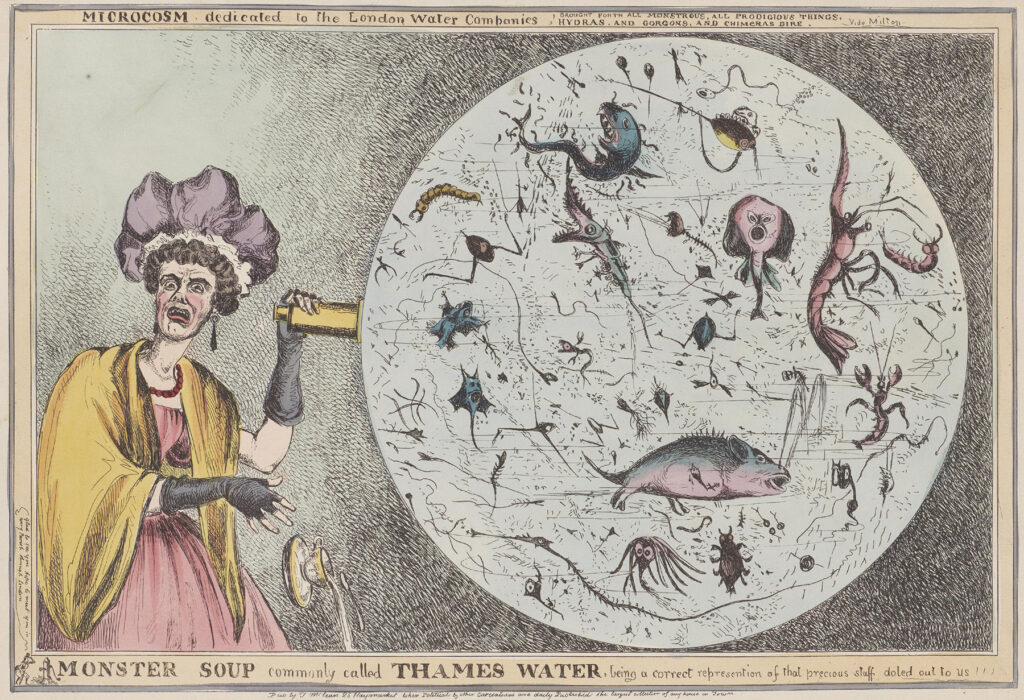
Monster Soup Commonly Called Thames Water, ca. 1828. William Heath’s cartoon lampoons the quality of London drinking water, often the source of typhoid and cholera outbreaks at the time.
Perhaps, they wondered, people who had experienced mild or asymptomatic infections were serving as unwitting long-term carriers of the Salmonella bacteria that cause the illness.
But confirming infections in apparently healthy people was a painstaking process. Investigators had to trace each person’s potential disease contacts, and repeatedly collect and analyze the subject’s urine and feces. Despite the effort, studies turned up very few hidden carriers.
Edinburgh University bacteriologists R. S. Begbie and H. J. Gibson decided to try something new—a quicker, less invasive, and, perhaps, less icky approach. Taking up recently invented methods of capturing and identifying bacteria, they tested wastewater for Salmonella in multiple sewer lines with the goal of identifying neighborhoods whose denizens were unknowingly excreting the pathogen. They pulled 58 samples from Edinburgh’s main sewers, incubated them, dyed them, and induced various biochemical reactions to identify bacterial strains.
Their experiment didn’t really succeed; it turned out chronic disease carriers weren’t producing the “massive discharge” of bacilli needed to detect typhoid. The scientists concluded they had only found Salmonella from people who were actively symptomatic or recently recovered.
But Begbie and Gibson’s study revealed something unexpected—they inadvertently found evidence of socioeconomic disparities in the neighborhoods studied. Residents of a “congested tenement area” produced far more bacteria than people living in a “residential suburban area of modern construction,” they observed in a 1930 paper. “In an upper-class residential district the habits of the people are such that spread from such foci does not arise.”
Like many future wastewater researchers, the bacteriologists showed no concern for the social ramifications of culling human data from sewage.
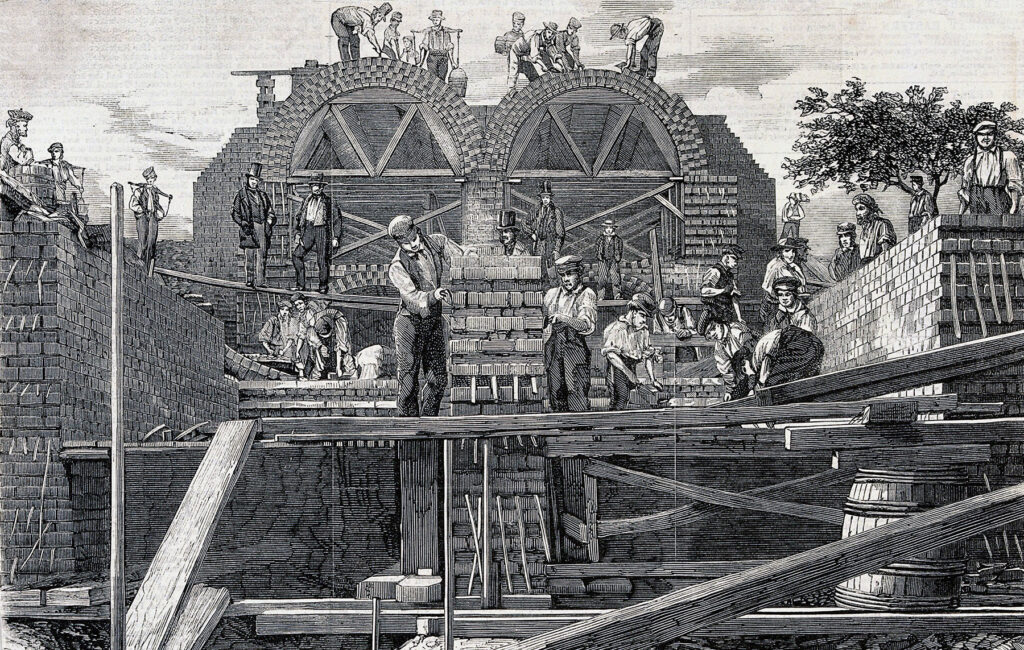
A sewer project in east London, as seen in an 1859 issue of Illustrated London News, engraving after a photograph by F. Thompson.
One of the few scientists to note the ethical challenges associated with WBE from early on was Brendan Moore, a public health official in southwest England who invented the “Moore swab,” a method for collecting sewer bacteria that remains in use to this day.
In the 1940s he tried his invention in a small seaside resort town that had seen a series of infections from paratyphoid, another disease caused by Salmonella. The bacteria was isolated and eventually traced back to the house of an ice cream van driver. The man’s wife turned out to be a chronic carrier who had both contaminated the ice cream and directly infected other people.
Moore then took his method to a larger town, where he discovered previously unsuspected infections in several households. Yet despite its obvious usefulness, he cautioned against using his new technique to identify or contact infected people unless it was truly necessary.
“Experience showed . . . that except in the presence of an outbreak, it was probably unwise to pursue infection back to the individual carrier,” Moore wrote in 1948. As he noted elsewhere, “We are left with the problem of whether the methods are of any value, and, if so, when they should be applied. These are matters for discussion and experience.”
Moore’s concerns were unusual and remained of little interest to most scientists, who perhaps were more focused on simply understanding whether wastewater had any role in spreading other diseases. Clarifying that question was no small task.
Like many future wastewater researchers, the bacteriologists showed no concern for the social ramifications of culling human data from sewage.
Polio outbreaks had struck Philadelphia, New Haven, Charleston, and other American cities in the 1930s. Frustrated local health officials called in epidemiologists to look for evidence the virus was being transmitted through sewage. But the task was slow and even more onerous than isolating typhoid.
The work required a large supply of monkeys, which were both scarce and costly at $6 to $8 apiece. Researchers would inject the animals with samples of wastewater, wait a few weeks for them to get sick, then remove their brains and spinal cords to examine the tissue under a microscope for telltale lesions.
Polio, the scientists determined, was not spreading through wastewater. But they did find that viral loads in sewage correlated with known infections: more infected people equaled more virus in sewer water. Because 99% of polio cases show few or no symptoms, health officials recognized that wastewater monitoring could give them a jump on outbreaks and help them respond before many people fell ill—particularly if they could speed up the process of detection. In the decades that followed, advances in cell culture methods allowed researchers to detect viruses in samples more quickly, without waiting weeks for monkeys to get sick.
In the 1980s wastewater-based epidemiology and biological research generally were revolutionized with the arrival of polymerase chain reaction (PCR) analysis of DNA, which allowed near real-time monitoring of polio and other diseases. Sewage surveillance has been a lifesaver in the years since. In 2013 and 2014 Israel detected a “silent” polio outbreak and launched a vaccination campaign before anyone suffered paralysis. In 2022 New York State began tracking polio in sewage water as it fought a scattering of infections in several counties around New York City.
Function Creep
While wastewater analysis was gradually perfected, essentially no thought was given to legal or ethical frameworks for its use.
Christopher Reimer, the University of British Columbia researcher, reviewed sewage studies from the 1950s to 1970s and found only brief allusions to ethical concerns. At most, researchers offered brief comments, as in the 1959 typhoid investigation, focusing only on the privacy of individuals identified as disease carriers. He found that they mostly eschewed discussion of broader societal impacts.
“I saw a discomfort from the scientists, like, ‘Oh, there’s probably some things we should be cautious about in doing this work.’ It’s usually two sentences, maybe a paragraph,” Reimer said in an interview. “‘We did this cool stuff, maybe we should think about it,’ and then moving forward like nothing happened.”
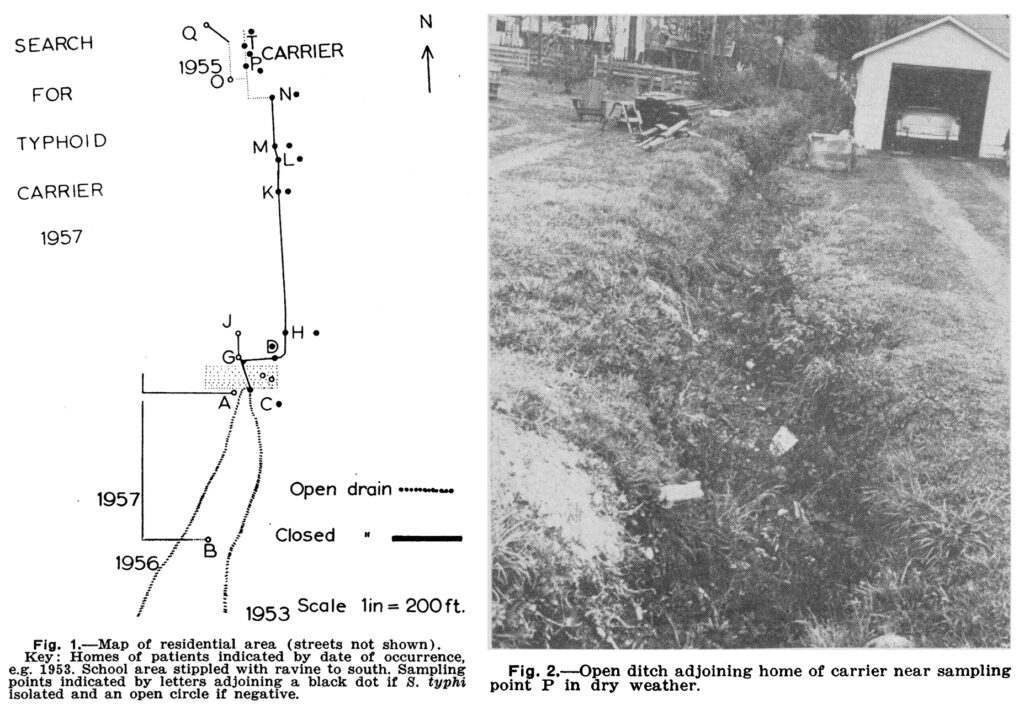
Figures from “Typhoid Fever: Where There’s a Case, There’s a Carrier,” Canadian Medical Association Journal, February 1959.
Yet research by Reimer, Arefin, and their colleague Carolyn Prouse has turned up more instances where targeted wastewater analysis has been used in ethically dubious and potentially troubling ways.
In 1962, for example, a Yale epidemiologist tested the sewage of incarcerated teenage girls in Middletown, Connecticut, without their knowledge and consent, to observe how a polio vaccination campaign affected the viral population in the sewers.
“Who would have been advocating for them or concerned about data justice, and the maybe unethical sampling of biological information? Not many people,” Arefin said.
When these kinds of technologies get rolled out in crises, as a quick fix to a problem, they often go with little public debate or ethical oversight.
In 1973 the South African government and gold mining companies set up a cholera surveillance system to ensure the stability of their pool of cheap immigrant laborers; the program’s health officers monitored sewage from the workers’ barracks and subjected some new recruits to invasive rectal swabs.
“The people who were doing this testing were the same people who were giving them housing, who were giving them transport, who were giving them everything,” Reimer said. In the context of the camp’s stark power imbalances, subjecting the workers to treatment based on WBE was ethically questionable, he said.
Arefin described wastewater surveillance as a “roaming technology.” Historically it pops up suddenly when needed and then disappears again, rather than becoming an established practice with built-up norms and controls. With WBE on an unprecedented upswing, now is the time to properly investigate and regulate the field, he said.
“When these kinds of technologies get rolled out in crises, as a quick fix to a problem, they often go with little public debate or ethical oversight,” he said. “If these technologies prove successful, they most likely will stay with us throughout the future and expand their scope and analysis.”

Workers holding identification papers at a South African mining camp, ca. 1960s. Photograph by Ernest Cole.
Arefin noted that wastewater surveillance sometimes includes “near-source” sample collection that can narrowly point to the location of a disease carrier. That could be a sewer pipe from a single building as opposed to a main sewer or sewage treatment plant. But because WBE studies do not involve medical treatment of patients and their findings are not considered traceable back to individuals, they do not trigger standard biomedical ethics reviews that examine the potential benefits and harms of the work and can require changes to study protocols.
Formal concerns about ethics and privacy of WBE only began to surface in the early 2000s as the scope of the United States’ long War on Drugs expanded into unexpected scientific domains.
In 2001 EPA chief of environmental chemistry Christian Daughton called for “non-intrusive drug monitoring” at sewage treatment facilities to better understand the impact of illicit drugs on plants and animals. The EPA tested the program in 2004. Two years later Jennifer Field, an environmental chemist at Oregon State University, launched a “community urinalysis” program that analyzed water from a city’s sewage treatment plant and revealed all the illicit drugs its population was ingesting.
But by the time Field’s project got going, her stated objective had changed. Rather than environmental protection, she pitched the program as a way to assess the growing problem of methamphetamine use in her state. That got the attention of Popular Science, the New York Times, and the Office of National Drug Control Policy, as well as civil rights lawyers and academics who study privacy.
“The possible application of community urinalysis techniques to an individual home’s wastewater frightens civil libertarians,” Christopher Hering wrote in a 2009 law review article, one of the first explorations of potential harms from sewage surveillance.
Hering, a law student at the University of Arizona at the time, reviewed questions such as who legally owns wastewater and whether sample collection should require a search warrant. He argued that a positive drug test of a neighborhood sewer could lead to responses that impact many innocent people, such as invasive door-to-door questioning by police.
Hering concluded that new laws and regulations were needed to govern so-called community urinalysis.
“As wastewater testing proliferates, courts, policymakers, and attorneys will need to grapple with its implications on privacy,” he wrote. “If none of these institutions act . . . citizens will be left at the mercy of advancing technology.”
A Pivot to COVID-19
By the 2010s, more WBE proponents were actively casting about for reasons to set up large-scale sewage surveillance.
Researchers at MIT proposed analyzing sewage to head off epidemics, then spun off a company called Biobot Analytics with the goal of monitoring patterns of opioid abuse. Arizona State University environmental engineer Rolf Halden, a longtime WBE advocate, measured opioid levels in Tempe, got an NIH grant to track flu outbreaks, and launched a project to monitor use of toxic chemicals nationwide.
Officials in Louisville, Kentucky, joined Halden’s opioid-tracking program after overdose deaths surged in 2016 and they realized they had underestimated the crisis. “Even our most aggressive estimates fell short of the reality. We needed a new source of data to be able to respond better, and earlier,” Grace Simrall, Louisville’s chief of civic innovation and technology, told Scientific American.
A smattering of scientists and academics started to plumb the legal and ethical implications of widespread surveillance. But then the pandemic hit.
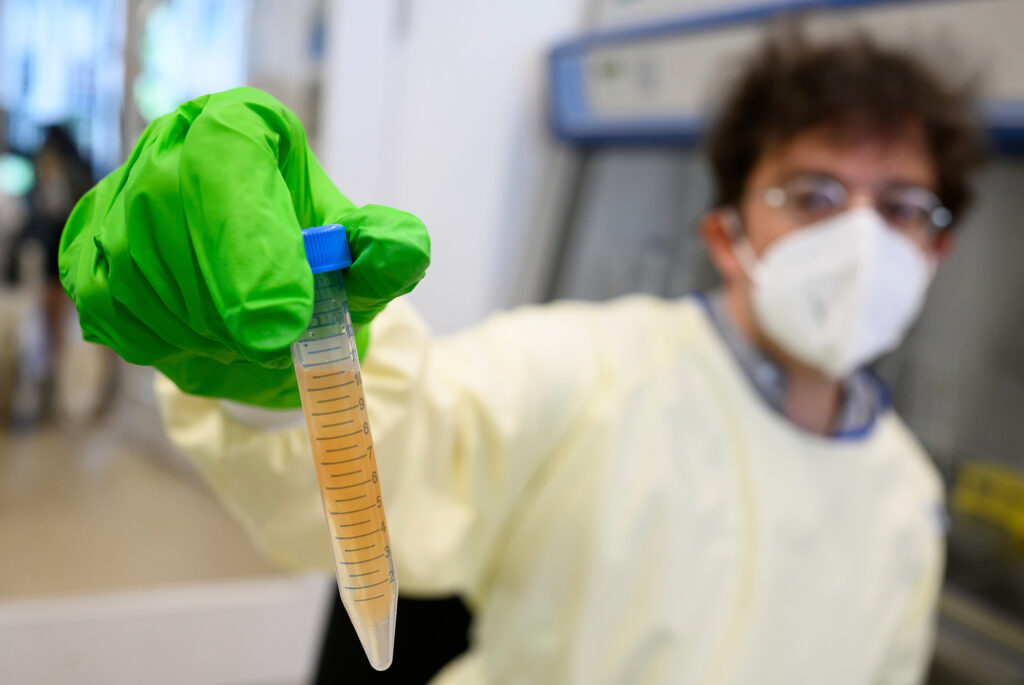
Molecular biologist Emanuel Wyler examines wastewater samples for disease at the Max Delbrück Center for Molecular Medicine in Berlin, August 2022.
Biobot, Halden’s lab, and many other groups rapidly pivoted to COVID-19 detection. WBE proliferated as governments, schools, prisons, hospitals, and businesses scrambled to work around shortages of clinical tests, map the spread of the virus, isolate new variants, and in some cases identify infected people.
In August 2020 the CDC created the National Wastewater Surveillance System. The Washington Post counted testing efforts at more than 170 wastewater facilities across 37 states, as well as programs in Singapore, China, Spain, Canada, New Zealand, Britain, and the Netherlands. By late 2022 the number of survey sites had reached more than 3,500 in 70 countries.
The new prominence of wastewater testing brought a surge of interest in potential uses of the technology and accompanying ethical challenges.
Halden co-authored a paper that called for guidelines on respecting the autonomy of research subjects, doing no harm, preventing discrimination, proper use of data, and other basic principles. Engineers, social scientists, and law professors published a stream of articles on similar topics: “The Datafication of Wastewater”; “COVID-19 Sewage Testing as a Police Surveillance Infrastructure”; and “Truth from the sewage: Are we flushing privacy down the drain?”
A smattering of scientists and academics started to plumb the legal and ethical implications of widespread surveillance. But then the pandemic hit.
Some of the more advanced efforts to set rules for wastewater surveillance are underway in Canada, where environmental scientist Steve Hrudey has raised the alarm about highly targeted sewer surveillance. Hrudey heads a Canadian Water Network panel that published ethics guidance for wastewater surveillance for COVID-19 in June 2021.
“The ethical issues that should guide environmental scientists and engineers in performing wastewater surveillance for SARS-CoV-2 must address the general goals of considering the common good, equity, respect for persons and good governance,” the panel wrote. “There is a need for an open dialogue that will reveal valid concerns for individual interests potentially in conflict with surveillance that is intended to serve the well-being of the population.”
Arefin said he’s less concerned about isolated instances of surveillance than the potential for various actors to quietly use real-time wastewater data to their financial advantage or to insinuate as-yet-unknown impingements on human rights.
Insurance companies could increase premiums or withhold coverage based on health data extracted from sewage. If a prison measures high levels of illegal drugs, it could conceivably ban family visits in an effort to stop drugs from getting in, harming all the prisoners and depriving them of a basic privilege to see their relatives, he said.
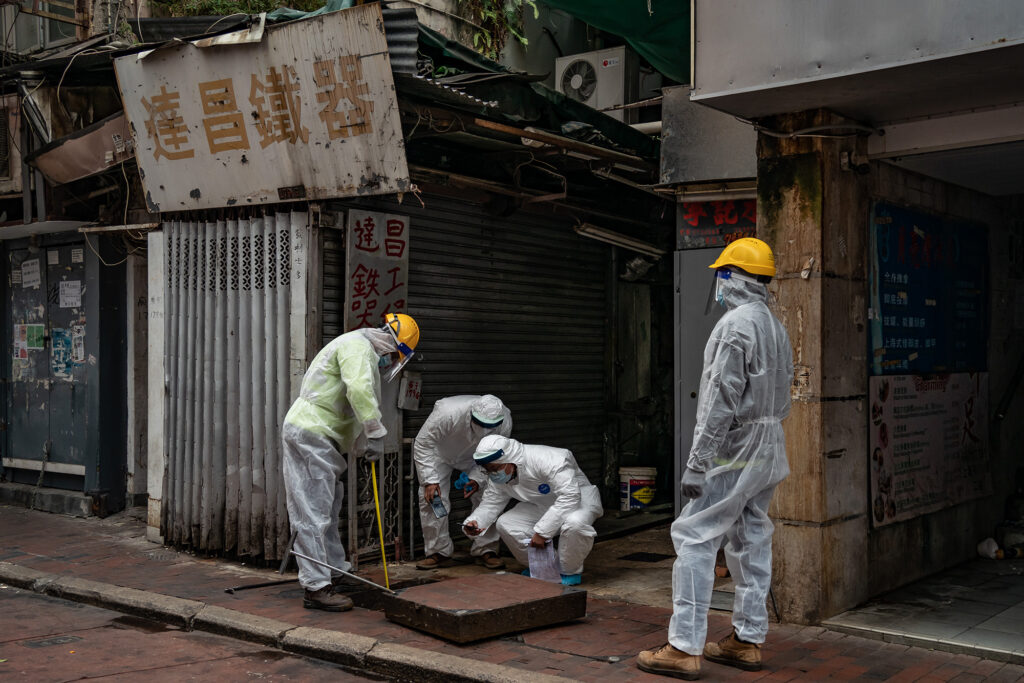
Workers examine the sewer in a Hong Kong neighborhood after a COVID-19 outbreak in the area, January 2021.
Many of the ethics discussions focus on the tendency for new surveillance and policing technologies to affect marginalized communities the most. Begbie and Gibson’s experiment showed how easily socioeconomic disparities can be detected in sewage, and the midcentury studies Arefin and Reimer uncovered repeatedly used WBE data from poor or powerless individuals in troubling ways.
Claire Duvallet, a data scientist at Biobot Analytics, argued in a blog post that data from sewage can be used to measure and protect the health of whole communities, including people whose needs are often overlooked or who do not have access to healthcare. At the same time, she recognized wastewater epidemiology as “a potential tool of oppression.” Like Arefin, she raised concerns about health insurers, who could argue that “objective” sewage-based metrics justify higher premiums in less healthy neighborhoods, thus reinforcing existing inequities. Employers could cite low COVID-19 levels in the sewers to justify unsafe return-to-work policies and overrule workers’ fears, she said.
“At its best, wastewater epidemiology will provide additional concrete evidence to motivate change and actionable metrics to quantify improvements. At worst, it will be deployed thoughtlessly and in ways that further entrench existing disparities,” Duvallet wrote.
She concluded that it is up to WBE technology leaders and entrepreneurs to prevent the worst outcomes from its wider deployment. Yet Arefin and Reimer say the engineers who design and operate wastewater-analysis technology typically have no experience with privacy or data security issues, making it critical to establish systems of transparent, interdisciplinary oversight with community involvement.
“We’re not against wastewater surveillance. We just think it needs to be subject to principles like data justice, and real community oversight and input,” Arefin said. “Surveillance has immense risks, but also—especially in a public health crisis—some real benefits, and it’s about ensuring that calculation is not just left up to scientists and public health officials.”
This article has been updated to clarify the source of Marlene Wolfe’s quote.

